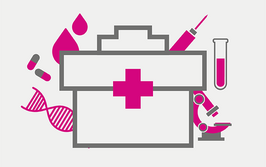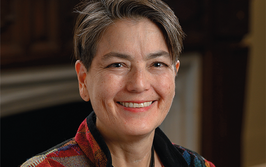
A Light in the Darkness
After the loss of an infant or child, uncovering the cause of death can be difficult – but has far-reaching implications
No death investigation is trickier or more fraught with ethical and legal concerns than one concerning a young child. And yet, these are the investigations where providing families with a conclusive cause of death can bring the most relief – and, in some cases, make the most difference to a court case. These cases are inevitably heartbreaking, so it is a true honor to be entrusted with them and to select the most sensitive and appropriate examinations to bring closure to the question: why did this happen?
A comforting connection
When speaking with parents after a post-mortem, I seek to provide some kind of consolation to them in their grief. As I specialize in the study of sudden infant death syndrome (SIDS), the cases I investigate are always tragic losses of very young, apparently healthy infants. After every post-mortem, I make myself available to explain my findings to the parents, because I consider these conversations a very precious duty. I take great care to show the parents how much the entire hospital team cared about their baby, so I carefully check the name, sex and circumstances before I introduce myself.
In general, I work to give parents a positive message on which to focus. For instance, in cases where a child has died from sudden infant death syndrome (SIDS), I let families know about a parent support group called the Lullaby Trust and provide information about the group’s helpline. I inform parents about the research we are actively conducting, and sometimes this discussion naturally opens up the opportunity to approach them for consent for future studies. It is a very difficult time – and above all we must be sensitive to the family’s needs – but the potential for some good to come out of the tragedy is often a comfort.
When we are able to provide it, the answer to the question of what happened also helps a great deal. I understand that the answer cannot eclipse the pain, but knowing the reason behind a death seems somehow healing. In fact, I find that part of my job very rewarding, because I can see the comfort provided by the answer – or the knowledge that we’re working as hard as we can to find one. I find it most important to communicate with the families at this time. When I diagnose a patient’s cancer, for instance, I know that that child will be seen immediately by an oncologist and started on treatment, so there is an entire care team participating in the process. After the death of a child, the pathologist may be the last health professional the family sees.
The future of death investigation
When I began studying cases presenting as “SIDS” in 2003, we were able to identify the cause of sudden unexpected infant death in only one out of every five cases. Nowadays, that number has risen to three out of five. What has caused this reduction in the number of unexplained deaths? Better post-mortem examinations contribute significantly. In 2004, Helena Kennedy led a report on sudden unexpected death in infancy (1) that put into place the first protocol for its investigation. At the same time, I was appointed head of my department, representing my hospital at meetings with coroners, midwives, mortuary staff, police, coroners, emergency and ambulance personnel. We became one of the first NHS Trusts in the United Kingdom to fully implement the protocol, which meant we also began helping other Trusts – first by assisting with their post-mortems, and then by actually performing them ourselves.
What does a sudden infant death investigation look like at Sheffield Children’s Hospital? Our protocol begins with microbiology; this allows us to investigate infections (bronchopneumonia, meningitis, hemolytic syndrome and so on), which explain about 30 percent of our sudden unexpected death population. Next, we do toxicology, which clarifies another 2 percent of deaths; then we look into things like cardiovascular conditions (10 to 15 percent of our population have a long QT mutation, 2 percent have an undiagnosed congenital heart malformation, and 3 percent have genetic conditions like cardiomyopathy). We take samples for metabolic analysis, which reveals the 3 percent of the population with undetected metabolic conditions – and then there are less common issues, such as mitochondrial diseases (approximately 2 percent of cases), abnormalities in the hippocampus or brain stem, and more. Some unusual genetic conditions are known to cause sudden infant death, but we don’t yet have methods to detect them in many of our patients.
We also do imaging studies, both as a service provision and for research. The main post-mortem magnetic resonance imaging (MRI) facility is in London – but, luckily, we are well-acquainted with the doctors there, so we sat down with them in 2014 and developed a business case for something completely innovative: the fetal and perinatal post-mortem MRI, which we offer to parents who don’t accept the traditional autopsy. We work in partnership with the radiology department, so after I complete my initial examination, the case goes to them for X-ray and MRI, and then comes back to us for the final report. We’ve done over 100 of these cases now, and we’ve identified a Relevant Condition at Death (ReCoDe) (2) in at least 90 percent of them. Considering that this technique is not the gold standard, that’s an excellent result – and it’s achieved at no additional cost and often within a 24-hour turnaround time. It’s sensitive to cultural needs, too; some families need to bury their children on the same day, whereas others don’t want the baby to be touched or to have any marks or scars. This method helps them, but it also helps us to improve our imaging and molecular genetics techniques, so it is a good balance.
Post-mortem MRI is diagnostically useful, of course, but with parental consent we can also keep the images and use them for future studies. We are currently collaborating on a project with the University of Sheffield’s Department of Sociological Studies in which they are considering the impact of bereavement on parents who have had either a traditional post-mortem or magnetic resonance imaging (MRI), evaluating people’s access to these services, and exploring how family members and professionals understand and interact with the images. With MRI, the parents can also keep the images of their child’s heart or brain or face; they can have a final, lasting memory to assist them in the process of grief – so the study also examines the impact of that on the family.
I think that this is the future of post-mortem examination. Imaging, genetic and metabolic testing, microbiology and toxicology will find a cause of death for two-thirds of patients, and only the remaining population will need a full diagnostic autopsy. This is the standard I am trying to develop and promote in my own department, although there are still obstacles to overcome. We are working with our genetics experts to develop a panel that can screen a battery of genes per case – something that I hope will become cheaper, easier and more widespread as genomics advances. We also don’t have a dedicated MRI scanner in the mortuary at the moment, but we expect to in the near future. These scanners are gradually getting smaller and more affordable, so I predict that every mortuary will eventually have its own. We haven’t quite achieved the “ideal” 21st-century post-mortem yet – and I believe we are still a decade or two away from it – but both the legal and the technological landscape are bringing us closer and closer.
Conflict in the courts
In the course of my work, I have seen post-mortem examinations where a test that could have been conducted was not, or where something that could have been spotted in the patient was missed. These all come as coroner post-mortems, so I take instructions directly from the coroner. In this role, I don’t have contact with the clinicians at the hospital where the death occurred. I make efforts to phrase my reports in a way that does not assign blame; the point of an inquest is not to ascribe fault, but to provide the facts of the matter, so these are the details I include in my report. Occasionally, in significant cases, the coroner will telephone me before the inquest for a conversation about my findings and I try to speak as neutrally as possible – but, of course, if I think something has been missed, I must be honest about that during the inquest.
Many of the cases I have dealt with in the past have been difficult because they represented “science versus science.” Shaken baby syndrome is a good example of this; in most instances, there are many signs that point to trauma – but also many that suggest other possibilities. For instance, the triad of subdural hemorrhage, encephalopathy and retinal hemorrhage could be the result of non-accidental injury, but may alternatively result from a metabolic condition or an infection. These post-mortems are carried out jointly with forensic pathologists. Some forensic pathologists treat these cases like trauma deaths in adults – but the way a child responds to trauma or disease is different to the way an adult would respond, and I feel that sometimes the subtleties and uncertainties are missed when the cases are investigated by professionals without pediatric experience. Medicine is never black and white, especially when it comes to infants and children, whose health is far less extensively studied. Unfortunately, in the Crown Court, everything has to be “black and white”; everything has to be true beyond reasonable doubt, because people’s liberties are at stake. It is difficult to reconcile medicine and law, so nowadays I try to avoid such cases and focus on research that I hope will eventually yield information that gives us better insight into unexpected deaths with uncertain causes. The downside to this is that many others have made the same choice – so there’s a serious lack of available medico-legal experts to address these challenging cases at the moment.
I had this same discussion recently with a prominent Queen’s Counsel. He asked me to take a case and I said, “I’m no longer doing this work, and neither is the other expert who can act for the Defense in this field.” He told me he would find one in the US. “They won’t come here either,” I replied. “I worked for the Innocence Project there, and they asked me what could be done to resolve the conflict between science and law – and I told them that the only thing I could do was to stop accepting these cases.”
Doctors and scientists alone cannot change the judiciary system. But, at the same time, we can’t participate in it in its current form, because it’s risky. You put your profession – your whole life – on the line when you state your opinion in court, and it isn’t always possible to be entirely certain. An investigation by the Karolinska Institute in Sweden commissioned a group of experts to search the literature for papers to substantiate trauma as a cause of Shaken Baby Syndrome. The group found 3,000 papers, of which only 100 met the criteria for inclusion and only two provided supportive evidence that shaking a child can cause the relevant symptoms. In my opinion, it’s not safe to base an entire court case on two papers. Eventually, I suspect we’ll reach a point where no one is willing to challenge such cases anymore, and then it will be a breach of human rights to try them in court – it wouldn’t be a fair trial if the defendant had no medical expertise on his side. This is why I believe that, to maintain a just legal system, the establishment is going to have to change to accommodate the inherent uncertainties of science and medicine.
Death investigation is a difficult subject for many reasons, and it is still in its early evolution. As technology advances, we get closer and closer to finding a cause of death in every case – and, increasingly, we can do so without a complete diagnostic autopsy. It’s my hope that, one day soon, we will be able to provide grieving families with the comfort of conclusive answers without the legal, technical and cultural obstacles we currently face.
- “Sudden unexpected death in infancy”, (2004). Available at: bit.ly/2vm3EMD. Accessed July 31, 2017.
- J Gardosi et al., “Classification of stillbirth by relevant condition at death (ReCoDe): population based cohort study”, BMJ, 331, 1113–1117 (2005). PMID: 16236774.
Marta Cohen is a consultant pediatric histopathologist at Sheffield Children’s Hospital, UK.




















